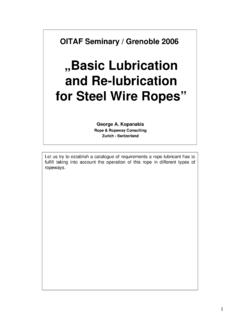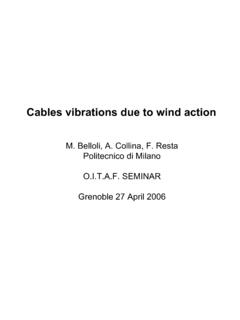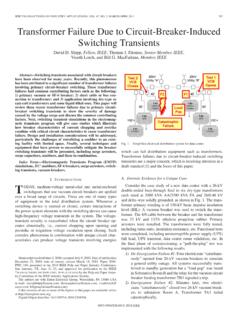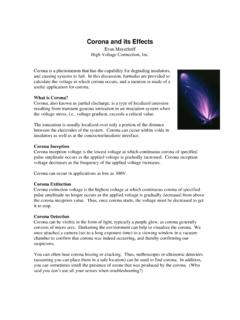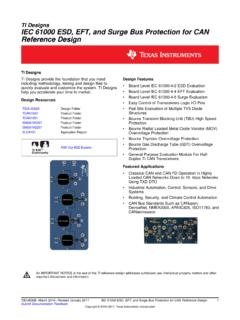Transcription of Structural behaviour of steel ropes subjected to …
1 Structural behaviour of steel ropes subjected to heavy thermal transients simulating fire scenarios , Monelli DIMTI University of Trento, via Mesiano 77 38121 Trento, e-mail: F. Degasperi SIF-LaTIF, Via Provina 24 38040 Trento,Italy, e-mail: A. Dallago, SIF-PAT, Via Brennero, 136 38100 Trento, Italy Abstract In this paper a methodology for determining the fire resistance of metallic wire ropes for ropeways and civil applications is presented. The problem has been faced by means of a numerical-experimental approach, focusing on the development of a simulation tool for the assessment of the rope response to heavy thermal transients resembling a fire scenario (ISO 834 standard temperature curve). To this purpose a Finite Element (FE) parametric model was built up, suitable for simulating the thermo-mechanical response of a wire rope.
2 The numerical predictions about load redistribution among wires during the test and rope's collapse conditions, allowed for safely carrying out the experimental fire characterizations of both full locked and strand ropes . The experimental results are in optimal agreement with numerical simulations thus allowing to consider the proposed methodology suitable for the analysis of the most diffused wire ropes configurations. Keywords: metallic wire ropes , fire resistance, damage scheme, standard ISO 834 curve, FEM. INTRODUCTION. The serious accidents occurred in the Alps in the winter season 2000/01 (Kaprun 2000, Zugspitze 2001). pointed out the lack of technical knowledge regarding the wire ropes behaviour in case of fire. As reported by Oplatka [1], who carried out an extensive analysis of recent fire accidents involving ropeways, the rope usually collapse in a relatively short time.
3 This problem is even emphasised by the ever increasing diffusion of ropes in civil buildings, bridges and cable car. The rope exposure to high temperature implies a rapid worsening of the wire's mechanical behaviours. The steel used for producing wires has a fine perlitic microstructure, characterized by an heavy hardening level which is responsible for the very high mechanical properties [2-4], Unfortunately, at a temperature higher than 300 C, the dislocation structure start to evolve determining an irreversible decrease of the mechanical strength. For temperatures higher than 600 C a recristalization process can take place producing a new crystallographic texture [5-8]. For long time exposure at relatively high temperatures creep phenomena can occur. However recristallization and creep contribution to the rope collapse can be excluded in case of fire due to the relatively short time of the event.
4 In the scientific and technical literature there is a lack of information on the rope behaviour during fire: the high costs of the experiments and the difficult set up of the experimental devices still represent a strong obstacle towards the acquisition of experimental results on different classes of ropes . It is therefore necessary to refer to papers and standards concerning the assessment of civil structures, which suggest different time- temperature histories to simulate the fire behaviour of the structure. The ISO 834 standard (fig. 1), which aims to simulate the time-temperature evolution in closed environments surrounding the structure during a fire accident [9-11], is one of the most frequently adopted approaches. The structure loaded to the in service' typical condition is monitored up to the final collapse or to the loosening of its functionality ( excessive deformation incompatible with Structural integrity).
5 The ISO 834 temperature curve overestimates of the fire heaviness: only the flash over phase is considered whereas the combustion initiation as well as the expansion phases, during which the temperature increase more slowly, are neglected. It is very difficult to transfer these concepts in the study of ropes behaviour . The ropes response and the thermal history of each single wire are hardly valuable during the fire transient . Tunnel fire Hydrocarbon fire Smouldering fire External fire Time [min]. Figure 1 Comparison among ISO 834 and other common time temperature histories (EN 1993 1-2). In scientific literature a great effort has been spent to understand the mechanical behaviour of wire ropes under different loading condition, whereas no theoretical, numerical or experimental contribution can be found dealing with the mechanical behaviour of ropes during heavy thermal transients.
6 In particular, several numerical and analytical models have been proposed with the aim of predicting loads sharing interaction among wires [2,12]. It has to be noted however that even though analytical models can predict the load distribution among wires, they are unfortunately unable to correctly describe the rope behaviour when subjected to heavy in service loading because of the complex phenomena such as contact, friction, plasticity and large displacements (full-slip regime vs. no-slip regime), which noticeably influence the mechanical response [13-25]. In order to face the analysis of these phenomena some numerical approaches based on the Finite Element (FE) Method have been successfully adopted [13-16]. In the present paper a numerical-experimental approach is developed for studying the mechanical behaviour of wire ropes undergoing to heavy thermal loads simulating a fire accidents.
7 The principal aim is to define a design tool for predicting the response of different classes of ropes . To this purpose a parametric FE model was manufactured, which allowed for the simulation of the rope's thermo-mechanical history during the fire transient following the ISO 834 standard. The FE analysis is very important for defining the experimental set up for carrying out experiments under safe conditions. The model has been validated on the basis of experimental data measured on the rope and on single wires: tensile tests at room temperature are used for defining the mechanical model whereas thermal histories measured in different positions of the rope and the surrounding environment are used to build up the thermal model. Moreover, in order to correctly simulate the mechanisms of load redistribution among wires during the thermal transient , an extensive campaign is carried out on single wires to build up a data base of wires curves at different temperatures.
8 These stress strain curves are used as input for the FE model for simulating the thermal transient of the rope subjected to in service' axial loading. The FE modelling of the thermo-mechanical response of the rope allowed to predict the load redistribution, the collapse mechanisms and the time to collapse at high temperature. The method represents the basis for defining a general purpose predictive tool suitable for studying different types of ropes usually adopted in ropeways and cable-structures. 1. WIRE ROPE'S CONFIGURATION. The study is focused both on full-locked and strand ropes . In particular, two specific geometrical configurations were considered: a 124 wires full-locked rope with a nominal diameter of 60 mm and a 186. wires Warrington-Seale 6x31 strand rope with a nominal diameter of 36 mm.
9 The full-locked rope The rope is characterised by a central straight wire, three layers of circular wires with alternate right-left lay and by three external layers of Z shaped wires also with right-left lay [fig. 2]. These ropes are typically used for cable-structures. The wires have higher cross sectional areas as compared to wires for cableways ropes , that have to be characterised by lower flexural stiffness. The effective cross section of the studied rope is nearly 2485 mm2, with a filling coefficient (ratio between effective and nominal cross section area) of nearly 88%. The chemical composition of steel wires is reported in table 1. / H Cross section N wires [mm] [mm2]. Core straight wire 1 5th Sixth layer 6 4th th 6. Fifth layer 12 3rd Fourth layer 18 2nd Third layer 23 H 1st Second layer 29 H H First layer 35 ( =circular wires diameter, H=thickness of Z shaped wires).
10 Figure 2 Geometry of the locked rope 60 [1 + 6 + 12 + 18 + ( 23 + 29 + 35 ) Z];. Elem. C Mn S P Si Sn Cu Al Mo Ni Cr V. % Table 1 Chemical composition of the steel wires The Warrington-Seale strand rope The rope configuration is labelled as 6x31WS+SF, made up by 6 Warrington-Seale strands each one of 31. wires and a polimeric inner core (PPC). The 12+6/6+6+1 strand cross section and the double helical winding configurations are schematically presented in fig. 3. Core Strand 1st Diameter (mm): PPC core 2nd Helical pitch (mm): 3rd 90. Wire diameters (mm): 1 6 6/6 (a) (b) 12 Figure 3 a) 6x31 WS configuration b) cross section of the WS strand 12+6/6+6+1. Mechanical properties of the wires The remarkable differences in the cross sections affect the mechanical strength of wires. An extensive experimental characterization was carried out to evaluate the effects of drawing operation.
